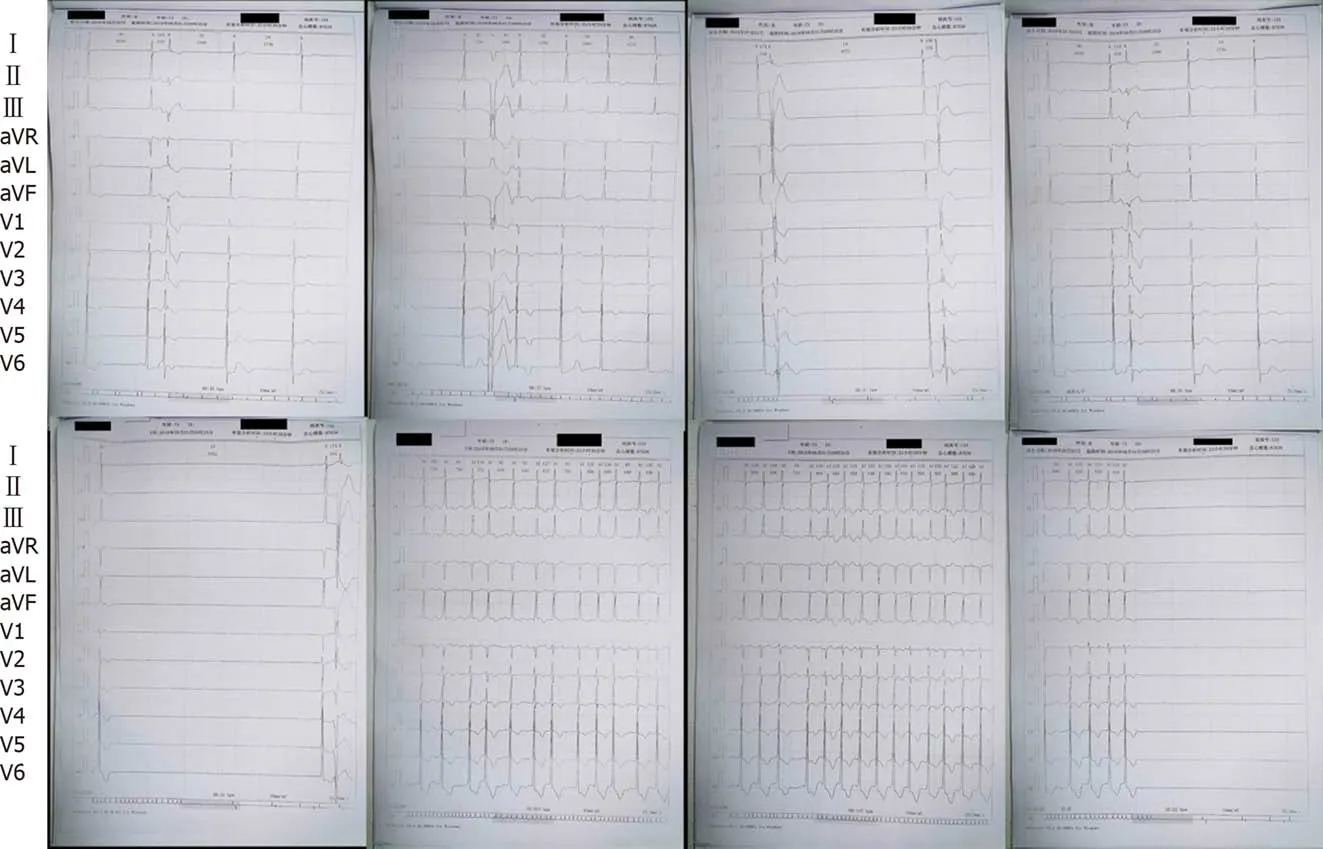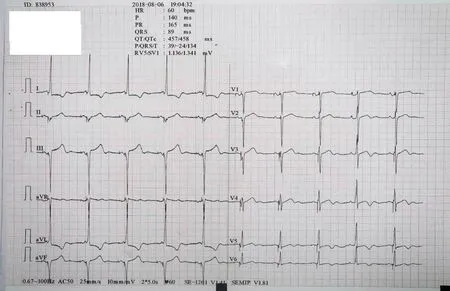Headache and sick sinus syndrome:A case report
2020-09-15
You-Cai Bi,Department of Neurology,Zigong Fourth People’s Hospital,Zigong 643000,Sichuan Province,China
Liang Gong,Department of Neurology,Chengdu Second People’s Hospital,Chengdu 650017,Sichuan Province,China
Abstract
Key words:Headache;Palpitations;Sick sinus syndrome;Differential diagnosis;Case report;Electrocardiogram
INTRODUCTION
Headache is a common neurological symptom with a multitude of different causes such as intracranial hemorrhage,infection,and migraine.Sick sinus syndrome is an arrhythmia phenotype attributed to sinus node dysfunction.The clinical symptoms of sick sinus syndrome include palpitations,dizziness,chest tightness,weakness,shortness of breath,amaurosis,and Adams-Stokes syndrome,among others.In this report,we describe a case of headache induced by sick sinus syndrome.
CASE PRESENTATION
Chief complaints
On July 30,2018,a 73-year-old female patient presented to our department with the chief complaint of recurrent paroxysmal headache for more than 7 years.
History of present illness
The headaches lasted from minutes to hours,and presented with moderate swelling and recurrent paroxysmal pain through the whole brain.The patient had paroxysmal palpations as well,usually followed by the headache episodes.However,headaches did not always occur every time after palpations.The patient’s blood pressure was normal when the headaches occurred.
例如:教师可以运用多样化的跳绳方式,例如甩大绳,多人一起参加,让两个人甩绳的方式来开展跳绳活动,这样的跳绳运动不仅加强了学生的体育健康素养知识,又调动了学生的思考能力,锻炼了学生的肢体协调性,让学生对体育大课间活动更加感兴趣。教师还可以指导学生采用“双人跳”的方式,对于忘记带跳绳的同学可以和其他同学一起完成跳绳运动,可以是背对着、面对着等方法一起跳,可以引发大脑的思考,也可以调动学生学习新鲜事物的兴趣,调动学生的积极性。我们应积极通过丰富多彩的跳绳运动来丰富学校生活,让学生更主动地投入到大课间活动,而不再是“课上听讲、课下趴桌子睡觉”的状态。
History of past illness
The patient has documented hypertension and type 2 diabetes,although blood pressure and glucose were well managed.
Personal and family history
The patient’s family history was unremarkable.
Physical examination
The patient′s heart auscultation was absolutely arrhythmic,heart sound intensities differed,and her pulse was deficient.Her blood pressure was 132/75 mmHg.The clinical neurological examination was negative.
Laboratory examinations
The patient′s thyroid function was normal.The liver and kidney function examination was also negative.
4 查看构图。用更高的ISO来拍摄测试照片,这样曝光时间就只有几秒钟。索尼A7 III有亮屏显示功能,在实时取景模式下可以提供更好的曝光模拟效果,这样你就用不到上面的窍门了。
Imaging examinations
A magnetic resonance imaging study and magnetic resonance angiography of the head performed at another center were normal (Figure1).
Electrocardiogram findings
The 24-h Holter electrocardiogram (ECG) monitoring study showed sinus bradycardia,sinus pause,AV junctional escape beats,ventricular escape,paroxysmal atrial flutter,and paroxysmal atrial fibrillation.The longest RR interval was 5.952 s(Figure2).
FINAL DIAGNOSIS
We arrived at a final diagnosis of sick sinus syndrome.
TREATMENT
The patient received dual-chamber pacing implantation on August 6,2018.The patient was prescribed Metoprolol Succinate Sustained-Release Tablets 47.5 mg twice a day and Amiodarone Hydrochloride Tablets once a day to control ventricular rate.
OUTCOME AND FOLLOW-UP
The patient’s paroxysmal headaches and palpitations had resolved within 1 year,confirmed by a follow-up telephone call.The ECG was normal after implantation of dual-chamber pacing (Figure3).
DISCUSSION
In this case,the organic lesion had not been considered when auxiliary examinations and a clinical neurological examination were both negative.Migraine was not considered on account of the patient’s age.When the patient described headaches following palpitations,we hypothesized that the headaches may have been related to an arrhythmia.After dual-chamber pacing implantation and pharmaceutical antiarrhythmic therapy,the patient was followed upviaa telephone call at 1 year.At that time,the patient reported resolution of her symptoms.Therefore,we believe that her headaches were related to sick sinus syndrome.
Common mechanisms of headache include:(1) Constriction,dilatation and extension of intracranial blood vessels caused by various pathologies;(2) Cranial and cervical nerve stimulation;(3) Elevated resting tension of the head and neck muscles;(4) Ophthalmologic and otorhinolaryngologic disorders,and cervical spine disease;(5) Biochemical factors and endocrine disorders;and (6) Neurological disorders.

Figure2 Twenty-four-hour Holter electrocardiogram monitoring results.
The incidence of headache as a symptom of sick sinus syndrome was not definite.No similar report was found in the literature.
Asvestaset al[1]reported a case of headache as a primary symptom of acute myocardial infarction.Huanget al[2]reported a similar case of a patient,who had been diagnosed with myocardial infarction and complained of headache without chest discomfort.Furthermore there have been multiple case reports of headache as the sole or cardinal symptom of myocardial infarction[3-6].Thus,the concept of headache being induced by cardiac factors has been presented.
Cardiac cephalgia is defined in The International Classification of Headache Disorders:2ndedition[7]and The International Classification of Headache Disorders:3rdedition[8,9].
There are four theories regarding the proposed pathogenesis of cardiac cephalgia.First,the heart is mediated by the autonomic nerve,visceral,and somatic fibers,which can converge on the same neurons in the spinal cord.Then the information induced by visceral afferents is relayed to the higher somatic region.Second,the reduction of cardiac output elevates left ventricular and right atrial pressure,which decreases cerebral venous refluxing and elevates intracranial pressure[10,11].Third,neurochemical mediators produced by myocardial ischemia can induce vasodilatation of the cerebral vessels and pain[10,11].Fourth,it is assumed that vasospasms can concomitantly occur in both coronary and cerebral vessels[10,12].
In this case,we hypothesized that arrhythmia led to myocardial ischemic and reduction of cardiac output.As a result of the arrhythmias,headache could be induced by stimulating visceral nerves and neurochemical mediators because of myocardial ischemia,and could also be induced by elevated intracranial pressure because of the reduction of cardiac output.Unfortunately,we did not monitor the variation of this patient’s cardiac output;thus,the possibility of other causes remains to be considered.
CONCLUSION
This case provides two novel insights.First,clinicians should pay close attention to predisposing symptoms and conditions.Second,it appears that arrhythmias can cause headaches.

Figure3 Electrocardiogram after implantation of dual-chamber pacing.
ACKNOWLEDGEMENTS
We thank the cardiologist for the expiation for the ECG.
杂志排行
World Journal of Clinical Cases的其它文章
- Assessment of diaphragmatic function by ultrasonography:Current approach and perspectives
- Computer navigation-assisted minimally invasive percutaneous screw placement for pelvic fractures
- Research on diagnosis-related group grouping of inpatient medical expenditure in colorectal cancer patients based on a decision tree model
- Evaluation of internal and shell stiffness in the differential diagnosis of breast non-mass lesions by shear wave elastography
- Real-time three-dimensional echocardiography predicts cardiotoxicity induced by postoperative chemotherapy in breast cancer patients
- Lenvatinib for large hepatocellular carcinomas with portal trunk invasion:Two case reports
